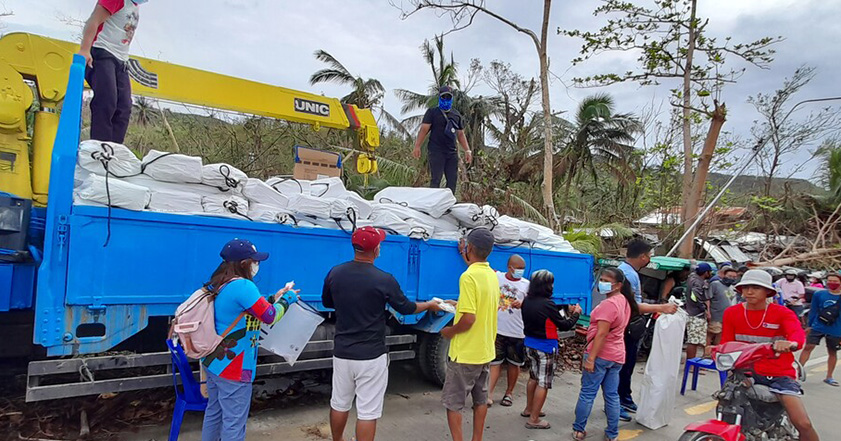Press release – 16 March 2022
ShelterBox is nearing in on sheltering around 100,000 people whose homes lay in the path of a super typhoon that hit the Philippines.
ShelterBox was one of the first charities to start distributing aid in the aftermath of Typhoon Rai that devastated the islands and damaged 1.7 million homes just as families were preparing for Christmas.
The Philippines is ravaged so frequently by severe storms that ShelterBox pre-positions aid in the country and has a four-person team based there permanently. It means the charity, which has worked in the Philippines more than 30 times, can scale up its response to meet the needs of people more quickly.
Dave Ray from Cornwall formed part of a small team from the UK that deployed to help ShelterBox Operations Philippines support the most affected communities to rebuild.
As distributions come towards an end, Dave says: “In total we will have reached 20,000 families by the end of this response. That’s around 100,000 people who have better shelter as a result of all the support we’ve had from our supporters.
“We have emptied our warehouse on this one so now it’s time to regroup, restock and prepare for the next time we are needed. With the help of our supporters, we can keep growing our presence here in the Philippines so that ShelterBox can be at the forefront of shelter responses here.”
The international disaster relief charity provides emergency shelter and other essential items to families across the world who have lost their homes to disaster and conflict.
The charity has been distributing aid including corrugated iron sheets, hurricane strapping, tarpaulin, rope and tools to island communities who are finding it most difficult to access essential resources to build shelter.
Dave says: “From what I’ve seen families are really getting the most use out of all the shelter items we’ve distributed and are really happy with the quality of them. Not many other agencies were around giving shelter materials, and the damage levels were extensive, so all the items are of great use to families.
“At the most basic level, a tarpaulin has made the difference between a shelter made of salvaged materials that leaks to one that doesn’t. That is a huge difference in itself, not only to the protection of household items and physical health but to people’s emotional and mental wellbeing.”
ShelterBox has been distributing solar lights to communities that don’t have a stable electricity supply, mosquito nets in areas known to have Dengue fever, as well as cash assistance.
Dave says: “Families have been able to buy new materials and hire skilled labour to construct strong new homes, which are so much more than a repaired shelter. There was a real sense of these new shelters being people’s new homes, as they would be using them for a long time. It’s been fantastic to see the sense of pride with which families were repairing and rebuilding the homes that had been destroyed.”
Robust local partnerships with Rotary, Humanity and Inclusion, and local governments have helped ShelterBox get aid to some of the hardest to reach locations such as Bohol.
“Our relationship with Rotary has been phenomenal and it’s been fundamental to the success of this response,” says Dave who has deployed for ShelterBox more than 30 times.
“Rotarians gave us local connections to communities that had been overlooked so we were able to assist them. They were at distributions providing amazing support there and the Rotary Club of Cebu connected us to suppliers and helped with transport.
“We are really proud of the support and friendship we are able to share together in times of disaster.”
Three months after Typhoon Rai made landfall, ShelterBox is looking to restock its in-country aid so it can be ready to respond to the next disaster.
“We are constantly working to be prepared for responding to disasters and to grow and develop our capacities, both in scale and in quality and being able to serve needs in a diverse way,” Dave says.
“Everywhere we respond we always make great local connections that serve well for the future. This ever-increasing knowledge is perfectly complimented by having prepositioned items in our warehouse in Cebu.
“This capacity, plus the understanding we’ve built up about how to effectively move aid anywhere in the country, means that we are constantly ready to respond to needs quickly, flexibly and with what communities really need to recover.”
To find out more about ShelterBox and its response in the Philippines visit shelterbox.org.

